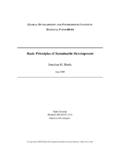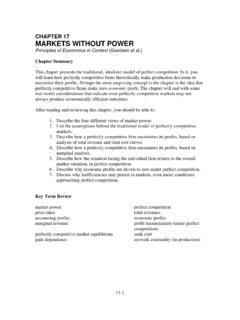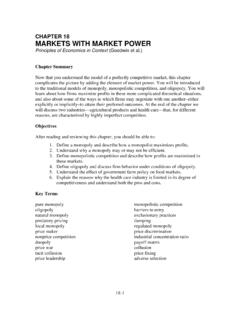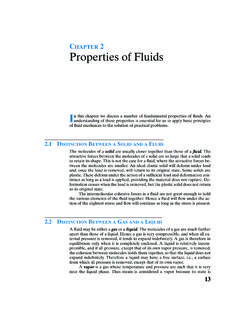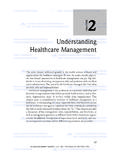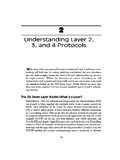Transcription of Resources, Environment, and Economic Development
1 322328 7/21/05 11:07 AM Page 17. C HAPTER F OCUS Q UESTIONS. What is the relationship between Economic growth and the environment? Will Economic growth encounter planetary limits? How can Economic Development become environmentally sustainable? CHAPTER 2. Resources, Environment, and Economic Development A Brief History of Economic Growth and the Environment Human population and Economic activity have remained fairly stable during much of recorded history. Prior to the Industrial Revolution of the nineteenth century, Europe's population grew slowly and standards of living changed little. The advent of the mar- ket economy and rapid technological progress altered this pattern dramatically. Popu- lations in Europe entered a period of rapid growth that led British classical economist Thomas Malthus to theorize that populations would outgrow food supplies, keeping the mass of people perpetually at a subsistence standard of living.
2 Malthus's Essay on the Principle of Population as It Affects the Future Improve- ment of Society, published in 1798, initiated a long and continuing debate on the im- pact of population growth. History has proved the simple Malthusian hypothesis wrong: both population and living standards in Europe rose rapidly throughout the two centuries following Malthus's Essay. But if we consider a more sophisticated argument, that a growing human population and Economic system will eventually outrun its bio- physical support systems, the debate turns out to have strong current relevance. The controversy over population growth is intimately intertwined with resource and environmental issues. In the twenty-first century these issues, rather than the sim- ple race between population and food supply, will strongly affect the course of eco- nomic Development .
3 It is unlikely that we will see major shortfalls in food supply on a global scale. But it is highly likely that the environmental stresses associated with a 17. 322328 7/21/05 11:07 AM Page 18. 18 PART ONE Introduction: The Economy and the Environment growing population and rising resource demands will require sweeping changes in the nature of Economic systems. Measuring Growth Rates In approaching complex growth issues, we can start with a simple Economic analysis of the relationship between population and Economic activity. Measuring Economic output in conventional terms as gross domestic product (GDP),1 we have the simple identity GDP (Population) (Per Capita GDP). which can then be expressed in terms of rates of growth as a relationship among GDP growth rate, population growth rate, and per capita GDP growth rate: GDP Growth Rate (Population Growth Rate).
4 (Per Capita GDP Growth Rate).2. To correct for the effects of inflation, we should use real GDP rather than nominal GDP in this Real per capita GDP will rise steadily, as long as real GDP. growth remains consistently higher than population growth. For this to occur, produc- tivity must also rise steadily. This increasing productivity is, of course, the key to escaping the Malthusian trap. Increased agricultural productivity means that the portion of the population working in farming decreases, freeing labor for industrial Development . Increased industrial pro- ductivity brings higher living standards. Broadly speaking, Economic Development has un- folded along these lines in Europe, the United States, and other industrialized nations.
5 Factors Essential to Economic Growth What determinants of increased productivity make this steady growth possible? One is accumulation of capital. Investment allows growth of capital stock over time: as capital stock per worker increases, the productivity of each worker increases. In addition techno- logical innovation raises the productivity of both capital and labor. Standard Economic growth models place no limits on this process. Provided investment continues at adequate rates, productivity and per capita consumption can continue rising far into the future. The ecological economics perspective focuses on three additional factors as essen- tial to Economic growth. One is energy supply. Europe's Economic growth in the Gross domestic product (GDP) is defined as the total flow of goods and services produced by an economy 1.
6 Over a specified time period, usually a year. 2. This relationship is derived from the mathematical rule of natural logarithms stating that if A BC, then ln A ln B ln C. The rates of growth of B and C can be expressed in terms of natural logarithms, and when added together they give the rate of growth of A. 3. Nominal GDP is measured using current prices. Real GDP corrects for inflation by using a price index to calculate the constant dollar value of production. 322328 7/21/05 11:07 AM Page 19. CHAPTER 2 Resources, Environment, and Economic Development 19. nineteenth century depended heavily on coal as an energy source, and some writers at the time expressed concern that coal supplies might run out. In the twentieth century, oil displaced coal as the prime energy source for industry.
7 Currently oil, natural gas, and coal provide more than 85 percent of energy sup- plies for the United States, Europe, Japan, and other industrial economies, and about the same proportion of industrial energy for the world as a To a great extent, Economic growth both in agriculture and industry has been a process of substituting fossil fuel energy for human labor. This substitution has important resource and envi- ronmental implications, which in turn affect projections of future growth. A second fundamental factor is supplies of land and natural resources, sometimes referred to as natural capital. Almost all Economic activities require some land use. As these activities grow, pressures increase to convert land from a natural state to agricul- tural, industrial, and residential uses.
8 Some uses conflict: housing may compete with farming for rural land, and industry or road building may make land less suitable for either residential or agricultural use. Land, of course, is fixed in supply. Except in limited cases such as the diked areas of the Netherlands, human technology cannot create more land. Natural resources vary in abundance, but mineral resources and the regenerative capacity of forests and other living resources have physical limits. The third important factor is the absorptive capacity of the environment for the waste products of industrial Development . This issue is not so critical when the scale of Economic activity is small relative to the environment. But as national and global eco- nomic activity accelerates, the flow of waste products increases and may threaten to overwhelm environmental systems.
9 Flows of solid wastes, sewage and liquid wastes, toxic and radioactive wastes, and atmospheric emissions all pose specific environmen- tal problems that require local, regional, and global solutions. Growth Optimists and Pessimists Debate is ongoing concerning resource and environmental factors that contribute to, and could eventually limit, Economic growth. In 1972 a Massachusetts Institute of Technology research team published The Limits to Growth, a study that used com- puter modeling to project drastic resource and environmental problems looming as a result of continued Economic growth (see Box 2-1).5 This report touched off a vigorous debate between growth optimists and pessimists.. For the most part, the optimists placed faith in future technological progress to tap new sources of energy, overcome any resource limitations, and control pollution prob- lems.
10 The pessimists pointed to the rapid growth of population and GDP, together with the already formidable array of existing environmental problems, to warn that humanity was in danger of overshooting the earth's capacity to sustain Economic activity. In effect, the question was whether the successful experience of Economic growth over the past two centuries can be sustained in the next century. Department of Energy, 2004. 4. Meadows et al., 1972. 5. 322328 7/21/05 11:07 AM Page 20. 20 PART ONE Introduction: The Economy and the Environment 2-1 The Limits to Growth Model The Limits to Growth model, presented by an MIT research team in 1972, ad- dressed the issue of physical limits to Economic growth. The study employed a model called World 3, which attempted to capture interrelationships between pop- ulation, agricultural output, Economic growth, resource use, and pollution.

